A History of the County of Buckingham: Volume 4. Originally published by Victoria County History, London, 1927.
This free content was digitised by double rekeying. All rights reserved.
'Parishes : Adstock', in A History of the County of Buckingham: Volume 4, ed. William Page (London, 1927), British History Online https://prod.british-history.ac.uk/vch/bucks/vol4/pp140-144 [accessed 23 April 2025].
'Parishes : Adstock', in A History of the County of Buckingham: Volume 4. Edited by William Page (London, 1927), British History Online, accessed April 23, 2025, https://prod.british-history.ac.uk/vch/bucks/vol4/pp140-144.
"Parishes : Adstock". A History of the County of Buckingham: Volume 4. Ed. William Page (London, 1927), British History Online. Web. 23 April 2025. https://prod.british-history.ac.uk/vch/bucks/vol4/pp140-144.
In this section
ADSTOCK
Edestocha (xi cent.); Adestoca, Adestocha (xii cent.); Adestok, Haddestok (xiii cent.).
Adstock covers 1,166 acres, of which 138 are arable, 898 permanent grass, and 15 woods and plantations. (fn. 1) The soil is clay. The parish is watered by Padbury Brook, which joins Claydon Brook, and forms the southern and eastern boundaries. The slope of the ground varies from over 370 ft. above the ordnance datum in the centre of the parish to 285 ft. in the south of the village. In the east of the parish are old gravel-pits, and at the time of the inclosure in 1798 allotment was made for them. (fn. 2)
The village of Adstock stands off the high road from Buckingham to Winslow in the south-west of the parish, the few houses of which it consists being grouped round the parish church of St. Cecilia. Several half-timber cottages of the 17th century, with roofs of tiles and thatch, still remain. A little distance to the north-east of the church is a halftimber house formed out of several tenements, and completely remodelled internally, which contains much re-used old woodwork. On the east side of the main road is an L-shaped 16th-century house with heavy timber framing. The present Adstock Manor in the south of the village was built in the middle of the last century. A Wesleyan chapel was erected here in 1889, a thatched barn having been previously used as a chapel since 1834.
The parish has always been purely agricultural, and is stated to be so in a 14th-century assessment for taxation, when Benet Berner claimed allowance on account of the failure of his bean and pea crops. (fn. 3) During the time of the Great Plague in the 17th century there is a tradition that, so greatly were Buckingham and Winslow infected, a market was held here for some time. (fn. 4)
Robert Sharrock (1630–84), 'accounted learned in divinity, in the civil and common law, and very knowing in vegetables,' was the son of the rector of Adstock. (fn. 5) Luke Heslop, who wrote on inclosures and their effect at the end of the 18th century, was rector from 1778 to 1803. (fn. 6) Charles Neate (1806–79), political economist, was born here. (fn. 7)
Adstock was inclosed in 1798, and the Award, with map, is preserved at the Public Record Office. (fn. 8) From it the following place-names have been abstracted: Mile Bridge alias Addington Planks, Darrell's Gate, Harrups Towns End, Fishers ford, Beggar Lane Close, Bootem Close, Haskell field, Pilch Common.
Manors
Previous to the Survey ADSTOCK MANOR was held by Gethe, (fn. 9) whose husband Ralph, apparently Earl of Hereford under Edward the Confessor, was degraded from his earldom by William I. (fn. 10) The manor belonged to William Peverel in 1086, (fn. 11) and was held in chief as of the honour of Peverel until 1518, (fn. 12) after which date no reference has been found to the honour in this manor. Adstock appears to have been the chief manor of the honour in this county, for in 1289 Alice de Luton owed suit for her two manors, to be paid 'at the king's court of the honour of Peverel at Haddestok.' (fn. 13)
Ambrose was the tenant of Adstock Manor at Domesday, (fn. 14) but after 1086 it was held by the lords in demesne. William Peverel was succeeded by a son or grandson of the same name, who took Stephen's side in the Civil War. In 1153 (that is, before ascending the throne) Henry of Anjou granted Peverel's lands to Ranulph Earl of Chester, who died the same year from poison administered, it is said, by Peverel. (fn. 15) After his accession to the throne Henry again confiscated the lands of William Peverel, who is not heard of after 1155. (fn. 16) Adstock Manor was granted to William Avenel, as appears from a document of the time of Henry II preserved among the Duke of Rutland's manuscripts, by which William Avenel granted Addington to Richard Vernon and Simon Basset, who had married his daughters. (fn. 17) Adstock thus became divided into two portions, the more important part, that which included the 'capital mansion' with two orchards, falling to Richard Vernon. (fn. 18) A few years later Richard and his wife Avis, together with William their son and heir, are found confirming to Azo son of Niel a virgate of land in Adstock, formerly belonging to Aluwi. (fn. 19) Richard Vernon was dead in 1195, when Simon Basset, Avis' brother-in-law, gave 100 marks to acquire Vernon's lands as the inheritance of his wife. (fn. 20) The Vernons, however, made good their claim, and in an undated charter of King John's reign William Vernon granted Adstock to his half-brother Robert, (fn. 21) though he, William, was acknowledged to hold half a knight's fee here in 1229. (fn. 22) At this date William Vernon also held Pitchcott (q.v.), with which Adstock descended (fn. 23) to George Vernon, who died in 1566 leaving daughters and co-heirs, Margaret wife of John Stanley and Dorothea wife of John Manners. (fn. 24) Two years later Henry Vernon brought a suit against Henry Vernon for the detention of the will of the Henry Vernon who had died in 1515. (fn. 25) These two Henrys must have represented a younger branch of the family, the defendant being possibly, as plaintiff states, heir male. (fn. 26) Adstock Manor went to Margaret Stanley, and during the next twenty years various settlements are found in her or her husband's name. In 1568 they made a settlement on Edward Armstrong and others, (fn. 27) in which settlement John Manners and Dorothea his wife joined them. (fn. 28) In 1577 Margaret, who was by this time a widow, appears to have received a quitclaim from Henry Vernon, probably the defendant of the case quoted above. (fn. 29) She shortly after married William Mather, (fn. 30) and in 1579, together with him, settled the manor on Edward Stanley, her son by her first husband. (fn. 31) Margaret Stanley died in 1596, (fn. 32) and in accordance with the settlement Adstock passed to Sir Edward Stanley, kt., of Tong Castle in Shropshire, (fn. 33) and the same year he with Lucy his wife made a settlement of the manor on Sir Francis Fortescue of Salden and Grace (Manners) his wife, (fn. 34) whose son John had married Frances daughter and co-heir of Sir Edward Stanley. (fn. 35) Francis and Grace Fortescue settled the manor in 1614, (fn. 36) and he died seised in 1624, his son John surviving him. (fn. 37) Previous to his death, according to Willis, he sold his demesne to six of the principal tenants of Adstock in fee, reserving to himself the titular manor. (fn. 38) Shortly after his father's death John Fortescue sold it to Thomas Egerton, then rector of Adstock, whose grandson conveyed it c. 1675 to Sir Ralph Verney. (fn. 39) Ralph Verney, Viscount Fermanagh, grandson of the above Ralph, held at the time Willis was writing. (fn. 40) Nothing further has been found about this manor, which, as above shown, was titular only, save Lysons's suggestion that it had amalgamated with the second manor in Adstock. (fn. 41)
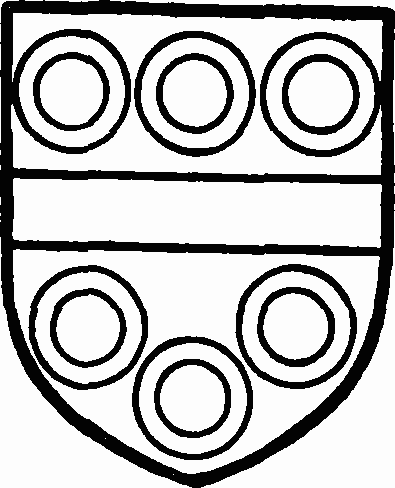
Avenel. Argent a fesse between six rings gules.
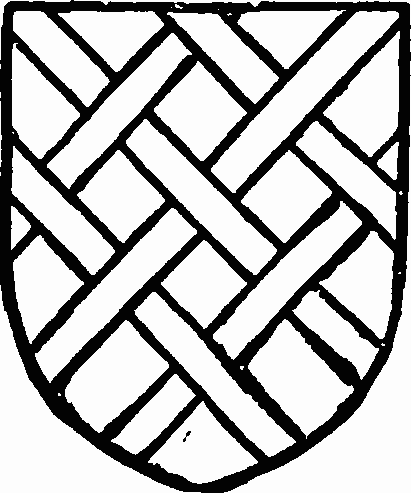
Vernon. Argent fretty sable.
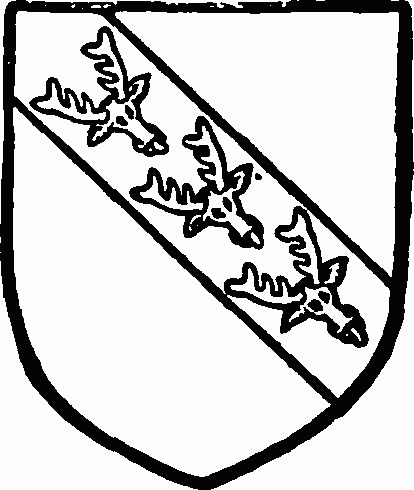
Stanley. Argent a bend azure with three harts heads caboshed or thereon.
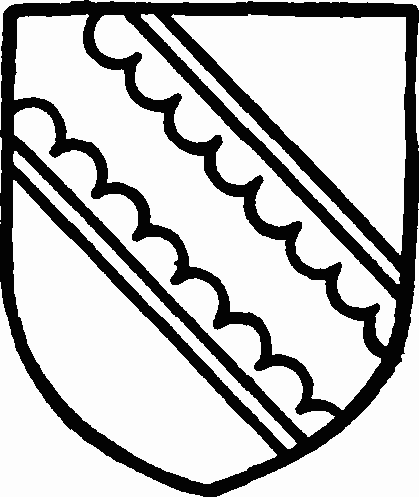
Fortescue. Argent a bend engrailed argent cotised or.
That portion of the Adstock estate which passed to Elizabeth daughter of William Avenel on her marriage with Simon Basset (fn. 42) is sometimes known as HAUSTED or ADSTOCK MANOR. Like Adstock, it continued to be attached to the honour of Peverel, last mention of which in this manor is found in 1626. (fn. 43)
Simon Basset died in or about the year 1205, when his widow Elizabeth paid a fine to the Crown. (fn. 44) In 1238 Robert Basset acknowledged the right of William Basset to one-fourth of a knight's fee and the rent of 3d. and 1 lb. of cummin in Adstock, which William had received from 'Elizabeth Avenel,' grandmother of Robert Basset. (fn. 45) About the same date William Basset is described in the Testa as holding half a fee of Robert here. (fn. 46) In 1245 a settlement on William Basset of onefourth of the 'manor' is found, with reversion to Elizabeth daughter and heir of Reynold Basset. (fn. 47) In 1249 William Basset died holding half a knight's fee in Adstock, a count with a close, a messuage, 1 carucate of land, 5½ acres of meadow, rents of freemen, customary rents and works and aids, worth in all £7 7s. 8½d. here. (fn. 48) It would therefore appear that the whole property had come into his ownership. His heir was his nephew Robert, son of John Basset, (fn. 49) who in 1252 obtained a grant of free warren in his demesne lands of Adstock, (fn. 50) but in 1280 the manor appears as the property of Robert Bardolf and Lora his wife, who then made a settlement by fine with their overlord, by which the third of Adstock, then held in dower by Regina wife of John la Chambre, was to revert to the Bardolfs, instead of to Roger Bozun. (fn. 51) Four years later Robert Bardolf was assessed for half a fee in Adstock, and mention is there found of an extraordinary number of intermediary lords, for he is said to hold of Roger Bozun, who held of Richard son of John, who held of Agnes Gryke, who held of Peter Basset, who held of Robert father of Peter, who held of the king in chief as of the honour of Peverel. (fn. 52) In 1305 Robert Bardolf died seised of Adstock Manor, his heir being Avis, then aged thirty years. (fn. 53) From her it passed to John de Hausted, who held in 1316. (fn. 54) He was made Seneschal of Gascony in 1327, and from 1332 until his death was summoned to Parliament as a baron. (fn. 55) In 1335 he made a settlement of Adstock on his son John de Hausted and his heirs, with reversion to himself. (fn. 56) John de Hausted, jun., appears to have predeceased his father, on whose death in 1336 the heir to Adstock was declared to be his son William de Hausted, then aged thirty. (fn. 57) In 1337 Fina, widow of John de Hausted, received a messuage, 120 acres of land, 4 of meadow, a plot of pasture, £8 11s. 2½d. rent and a windmill in Adstock as dower. (fn. 58) William de Hausted died without issue before 1346, and his lands passed to his sister Elizabeth. (fn. 59) Joan de Den, who may possibly be her daughter, held this fee in 1346. (fn. 60) In 1393 John Cope and Elizabeth his wife held Adstock Manor (here called Hausted for the first time), (fn. 61) and it seems likely that it had passed to the Cope family by marriage, for Adstock certainly follows the same descent as Denshanger (Northants), which John Cope held by the courtesy of England in 1397. (fn. 62) At this latter date he bought all rights in the reversion of Denshanger, (fn. 63) a third of which came to him on the death of Amy widow of William Hausted in 1400, (fn. 64) and, though no record has been found, a similar transaction appears to have taken place with regard to Adstock, which is now found in the Cope family for several generations. John Cope died in 1417 and was succeeded by his son John Cope, (fn. 65) whose widow Joan Cope held the manor till her death in 1434. (fn. 66) Stephen Cope, her son, next became lord of the manor, which on his death in 1445 passed to his son John Cope, (fn. 67) mentioned in connexion with Adstock in 1489. (fn. 68)
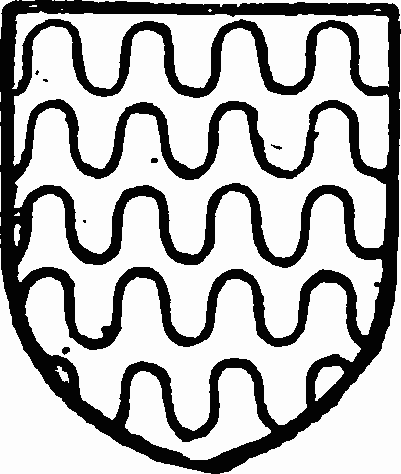
Basset. Barry wavy argent and azure.
Adstock Manor is next heard of in 1511, when it was settled by Benedict Lee and Isabel his wife on John Clark and other trustees. (fn. 69) Isabel was possibly an heir of the Copes, and certainly seems to have had some special connexion with Adstock, for Benedict Lee, who survived his wife and married again, directs in his will, dated 21 February and proved 17 April 1545, that a yearly obit shall be made in Adstock Church for the soul of his wife Isabel. (fn. 70) In 1568 Robert son of Benedict Lee made a settlement of the manor on Valentine and George Pigott. (fn. 71) Three years later further settlements took place, which resulted in the final alienation, through Anthony Jackson, of the manor to Thomas Smythe. (fn. 72) Christopher Smythe, whose relationship to Thomas has not been traced, held Adstock in 1576. (fn. 73) He settled it on Thomas Smythe in 1583, (fn. 74) and he with his wife Ellen alienated it to Robert Tomlyns in 1586. (fn. 75) Robert Tomlyns held the manor at his death in 1622, when it passed to William Tomlyns, his son and heir. (fn. 76) Other members of this family subsequently held Adstock. Richard Tomlyns held a court baron for the manor here in 1647, (fn. 77) and in 1676 Jonathan and Samuel Tomlyns finally sold it to William Greaves. (fn. 78) His daughter married a member of a family called Whitehale, (fn. 79) and the manor continued to remain with the Whitehales, of whom Charles Whitehale and Hester his wife combined with Matthew Shelswell and others in a settlement of Adstock in 1707. (fn. 80) This family were still holding in 1735, (fn. 81) but by the end of the century had been displaced by the Turneys, of whom John ClarkTurney held in Lysons' day. (fn. 82) In 1798 John ClarkTurney and Elizabeth Goodman, widow, are returned as joint lords of the manor. (fn. 83) In the middle of the 19th century James Hawley was lord of the manor, (fn. 84) which at the present day belongs to Mr. Charles Matthew Prior.
Church
The church of ST. CECILIA THE VIRGIN consists of a chancel measuring internally 25 ft. 6 in. by 15 ft., nave 38 ft. 6 in. by 21 ft. 6 in., south porch 6 ft. 6 in. square, and a west tower 10 ft. by 9 ft.
The nave walls, up to the sills of the windows, belong to a 12th-century church, the chancel of which was rebuilt about 1330, when the north porch was added. The upper part of the nave walls was taken down and erected anew late in the 15th century, the date of the addition of the tower. The building was restored throughout in 1875. The walls of the body of the church are of rubble, but the tower is faced with ashlar.
The chancel is lighted from the east by a window of three trefoiled lights with tracery in a pointed head, and from each side wall by two pointed two-light windows of the same type. The westernmost window on each side is transomed to form a low-side window, the lower portion retaining the staple of the shutters with which it was fitted. All these windows are of 14th-century date, though much restored. Between the two north windows is a contemporary doorway with a pointed head, now blocked, and in the south wall is an original piscina niche with a trefoiled head. The chancel arch is pointed and of three chamfered orders recessed only on the nave side, the innermost order springing from modern corbels. The chancel roof retains a truss bearing the date 1597.
The four windows lighting the nave, two in each side wall, are each of three transomed cinquefoiled lights with a pointed and traceried head, and are contemporary with the late 15th-century rebuilding. Between them are the north and south doorways, both of which, though partly reset, are substantially of the 12th century. The former is now blocked; it has a round-arched external order, the head enriched with foliated ornament in beaded semicircles, and inclosed by a label with 15th-century head-stops. The jambs are chamfered and the imposts are ornamented with the indented moulding. The head of the doorway itself has been brought to an ogee form by cutting out part of the tympanum which originally filled the head of the external order. The south doorway has 12th-century shafted jambs with curiously sculptured abaci and capitals to the jamb shafts, but the pointed head is of the 15th century. The jambs of both doorways have several incised crosses. The roof of the nave, which is dated 1599, is an interesting example of late 16th-century work. The trusses have pierced pendants and tracery in the spandrels of the wall brackets.
The outer doorway of the south porch has a pointed head of two orders moulded continuously with the jambs; the window in the east wall is modern.
The tower is crowned by an embattled parapet and is of two stages with a vice at the south-west and diagonal buttresses at the western angles. The west window of the ground stage is of two cinquefoiled lights with a pointed and traceried head, and the tower arch is of three pointed orders. The bellchamber is lighted by louvred two-light windows, that in the south wall being apparently a re-used window of c. 1400. The other windows have square heads and are of the same date as the tower.
The font is of the 15th century and is octagonal with panelled sides to the bowl. The altar table is of about 1600. Three traceried heads worked into the panels of the pulpit appear to be remains of screenwork. The plain south door bears the date '17XX2' (1722) scratched upon it, though the workmanship looks earlier. Inserted in the gable over the outer entrance of the porch is a sundial with the date 1581 and the initials T.E.
There is a mural monument dated 1720 to the third of three Thomas Egertons, who were rectors of the parish, and another to Alexander Burrell, rector, who died in 1771.
There are two bells and a sanctus. The first, inscribed in Gothic small with crowned capital initials, 'Sancta Anna Ora Pro Nobis,' is by John Sturdy, (fn. 85) the second is inscribed 'Richard Chandler made me 1676,' and the sanctus, probably by Mears, bears the date 1826. (fn. 86) On the frame is cut the date 1618 with the name IOHN IEFS.
The plate includes a cup and cover paten of 1569, a pewter paten and flagon, and a modern plated almsdish.
The registers begin in 1538.
Advowson
The church of Adstock, together with a carucate of land, formed part of the grant of William Avenel to the Abbot and convent of St. Mary de Pre, Leicester. (fn. 87) In 1221 Robert Vernon, clerk, under age, was presented by the convent and admitted by dispensation of the bishop, who ordered a perpetual vicarage of 5 marks to be instituted and a fixed pension reserved to the abbey. (fn. 88) If the vicar so appointed died within seven years, and while Robert was studying at the schools, he (Robert) was to appoint another, but if later Robert might take the whole church. (fn. 89) Six years later the abbot and convent presented Robert de Eddeshoure, (fn. 90) who was accordingly instituted, but subsequent presentation are to rectors. In 1282 the Bardolfs unsuccessfully tried to wrest the presentation from the abbot. (fn. 91) Adstock was taxed at £6 13s. 4d. in 1291. (fn. 92) In 1423 Thomas Thowe, rector of Adstock and of 'noble birth,' received a dispensation to hold another living in conjunction with this one, the value of the two not to exceed 30 marks. (fn. 93) This dispensation was renewed in 1427. (fn. 94) He was the last rector presented by the abbey, which seems to have come to some arrangement with the lords of the manor, by which the latter resumed the right of presentation. (fn. 95) At the Dissolution the rectory was said to be worth £18 6s. 8d. (fn. 96) In 1609 Sir Francis Fortescue, lord of the manor, conveyed the advowson to Peter Fige for a turn. (fn. 97) The lord of the manor retained the right of presentation until about the year 1635, when Sir John Fortescue alienated the advowson to Robert Sharrock, rector of Drayton Parslow, (fn. 98) from whom a turn was purchased in 1671 by Thomas Egerton, then lord of the titular manor. (fn. 99) In 1707 Robert, grandson of the above Robert Sharrock, bequeathed the advowson to the Bishop of Lincoln and his successors, (fn. 100) by whom the right of presentation was exercised till the 19th century. (fn. 101) By the middle of the last century it had passed to the Hart family, (fn. 102) of whom Edward Hart owns the advowson at the present day.
At the inclosure of the parish the rector received 300 acres allotted in lieu of tithes. (fn. 103)
In 1456 licence was granted to one priest to serve the neighbouring churches of Adstock and Addington, the issues of which were said to be sufficient for only one chaplain, who was to say mass daily in each. (fn. 104)
Charities
The church lands, containing 4a. 2r. 4p., were allotted to the churchwardens by the Inclosure Award of 13 August 1798 in lieu of several dispersed parcels of land in the open fields. The land is let at £7 a year, which is applied towards general church expenses.
The Emily Bayne's charity of 1911 yields annually from consols £7 13s. 4d., which is distributed in coals on St. Thomas's Day to the aged and deserving poor.